Ten years of Ethereum, with its ups and downs, just as the market is heating up again, the ETH price seems only a step away from its historical high.
This article analyzes seven dimensions including institutional accumulation, ETF fever, changes in the foundation, K-line technical indicators, on-chain data, roadmaps, RWA, and the rise of stablecoins; perhaps this round of Ethereum's rise has just begun.
1. ETH Reserve Concept Stocks
Recently, buying in the ETH market has been unusually strong, with many listed companies and asset management institutions actively increasing their holdings, even incorporating ETH into their core financial strategies. Meanwhile, ETH reserve concept stocks have surged, becoming new favorites in the U.S. stock market.
The hallmark event that triggered Wall Street's embrace of Ethereum was prominent strategist Thomas Lee of Fundstrat publicly betting on ETH. In 2025, he became the chairman of Bitmine, directly pushing this former Bitcoin mining company to transform into an Ethereum asset firm. Under Lee's leadership, Bitmine quickly accumulated over 600,000 ETH positions in the market, worth over $3 billion, as a major asset for fiscal reserves. It was also under his marketing inspiration that Wall Street's excitement was ignited, with several U.S. publicly listed companies subsequently announcing the purchase of ETH as part of their asset allocation. For instance, previously, Bit Digital converted its held BTC into ETH, spending $172 million to acquire 100,000 ETH, now totaling over 120,000 ETH; SharpLink Gaming currently holds about 438,000 ETH, with a total value of approximately $1.09 billion.
This series of actions indicates that institutional investors are viewing Ethereum as a strategic reserve asset similar to Bitcoin, significantly enhancing Ethereum's market recognition and further strengthening bullish expectations.
2. ETF
With the surge in ETH prices, significant off-exchange funds have flowed into Ethereum ETFs.
According to SoSoValue data, as of July 29th, Eastern Time, the total net inflow of Ethereum spot ETFs reached $219 million, continuing a net inflow for 18 consecutive days since July 3rd. The spot ETF with the highest single-day net inflow is Blackrock's ETF ETHA, which had a single-day net inflow of $224 million, bringing the historical total net inflow of ETHA to $9.704 billion. On July 16th, nine spot Ethereum ETFs in the U.S. attracted a total net inflow of over $726 million, setting a new single-day record since their launch in July last year.
In contrast, during the same period, U.S. Bitcoin ETFs cooled down after the initial hype at the beginning of the year, with a slight net outflow for several consecutive days in late July, indicating that some funds rebalanced from the BTC sector to the ETH sector, reflecting an increase in institutional confidence in the application prospects of Ethereum. Currently, the market capitalization of Bitcoin ETFs accounts for 6.49% of the total bitcoin market value, while Ethereum ETFs only account for 4.71%. In contrast, there is still substantial room for growth in the funds flowing into Ethereum through ETF channels.
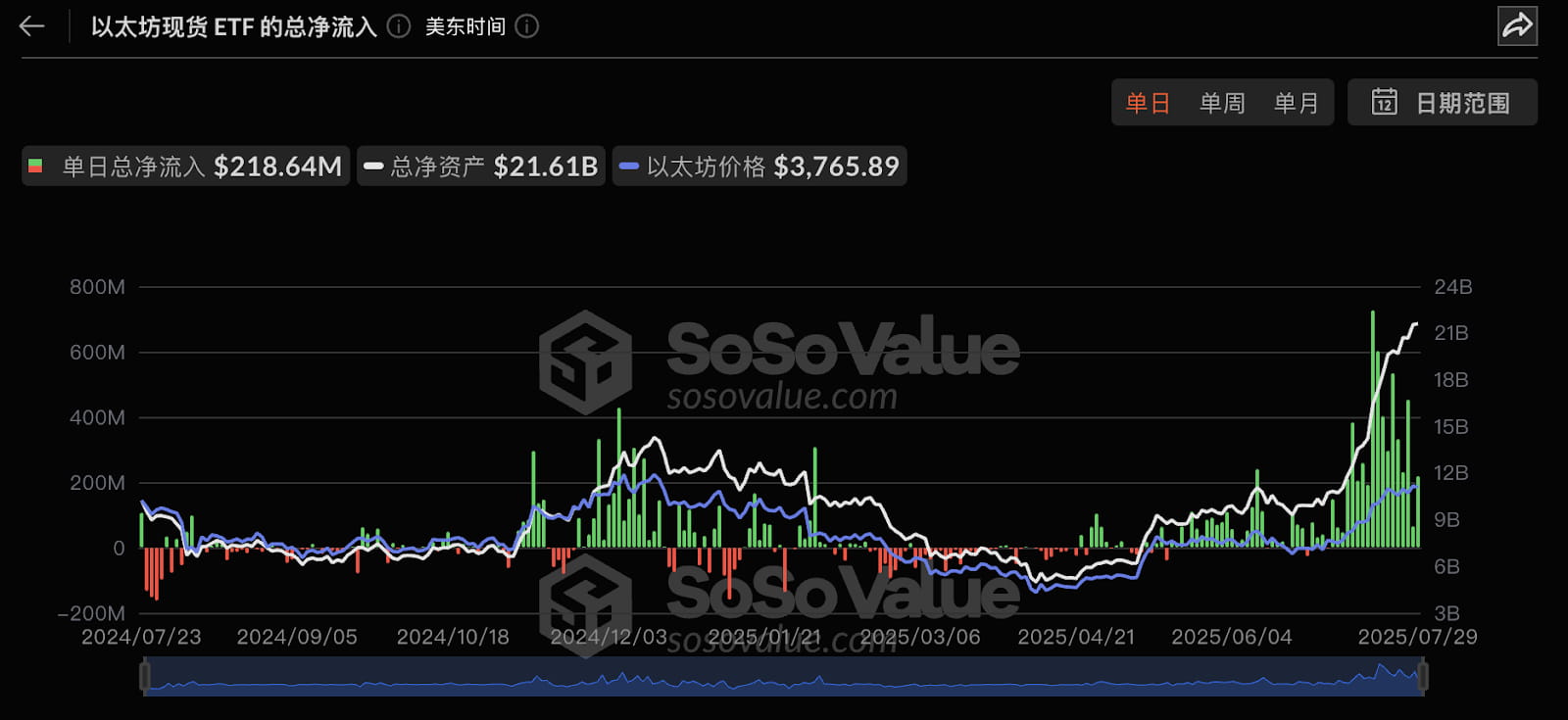
Source: SoSoValue
Looking ahead, in addition to spot ETFs, Ethereum staking yield ETFs are also on the way. On July 17, Blackrock's iShares Ethereum Trust (ETHA) officially submitted the 19b-4 document to the SEC, intending to introduce staking features for its Ethereum ETF. According to analysts' forecasts, the U.S. is expected to approve the first batch of ETH staking ETFs in the second half of 2025. These products will offer an annualized staking yield of 3-5% based on the holding of spot Ethereum, making them more attractive to institutions.
The most direct impact of the ETF effect on Ethereum is the enhancement of liquidity and demand ceilings. After institutions allocated BTC ETFs, ETH ETFs became the only option next. With ETFs, large funds at the level of hundreds of billions of dollars can easily allocate assets, which undoubtedly significantly enhances the investment attributes and market depth of ETH, being one of the important external factors supporting a long-term bullish outlook.
3. Ethereum Foundation
This round of Ethereum's strength is also closely related to changes in the management team.
The Ethereum Foundation underwent management adjustments in the past year. In March 2025, Hsiao-Wei Wang and Tomasz Stańczak were appointed as co-executive directors of the foundation. This dual leadership model will decentralize decision-making power, reduce single-point dependency, and, alongside technical leaders like Vitalik, introduce more professional management to promote efficiency. It retains the community-driven open-source spirit while enhancing external communication and strategic execution, facilitating healthy interactions between Ethereum and institutions and regulators.
Additionally, former core researcher of the Ethereum Foundation, Danny Ryan, joined the Etherealize project founded by former banker Vivek Raman, aiming to bring ETH into the mainstream financial system on Wall Street through education for traditional institutions and market promotion. This marks the first time the core Ethereum team has actively integrated into the traditional financial ecosystem, and the valuation logic of ETH will shift towards institutionalization, significantly enhancing long-term price support.
4. K-Line Technical Indicators
Ethereum has recently demonstrated a strong upward trend. In the past month, the price of ETH has significantly increased by about 60% from around $2,400, approaching the $4,000 mark in late July. The increase far exceeds the market average, reflecting optimistic expectations for Ethereum.
From a technical indicator perspective, in the past three months, ETH/BTC has ended a long period of sideways consolidation and broke through a key range upward in mid-July, increasing by 40% in a single month, indicating that the previously Bitcoin-dominated fund preferences are beginning to shift towards Ethereum, and market preference for risk assets is recovering.
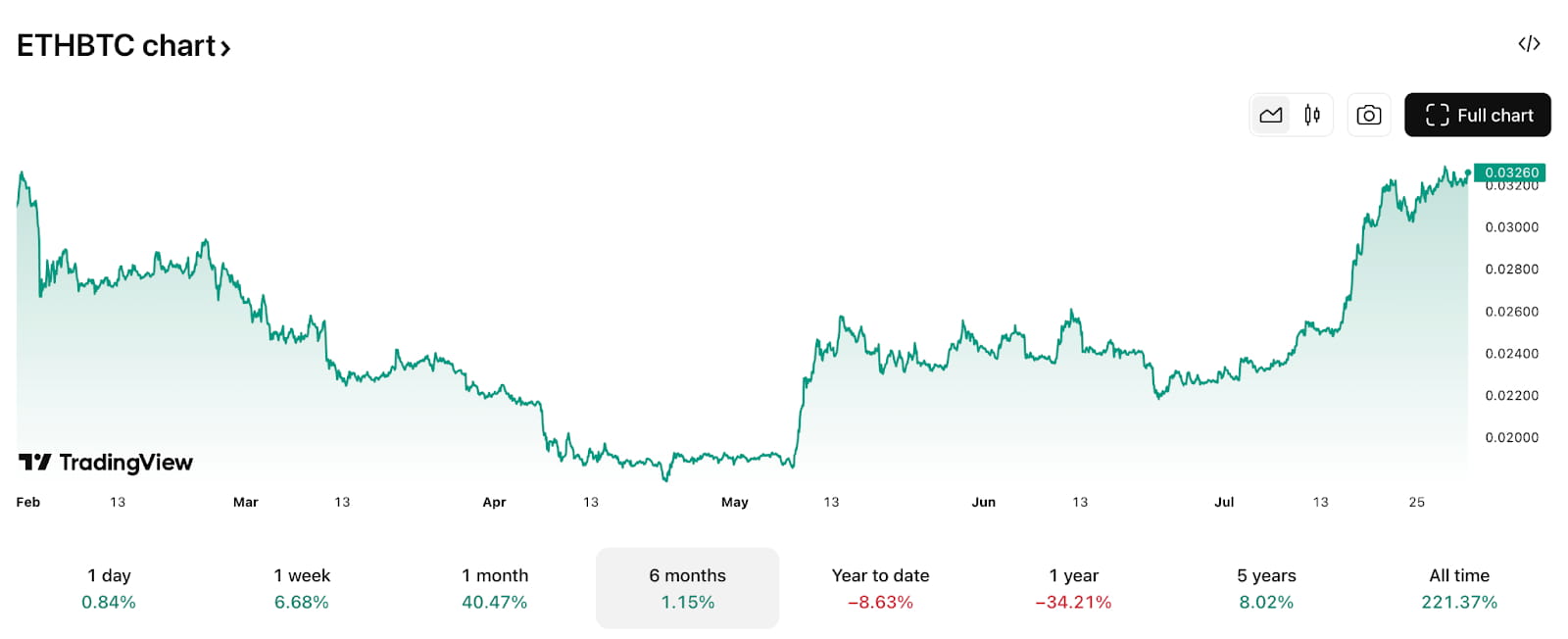
Source: TradingView
Additionally, ETH's RSI (Relative Strength Index) fell back to around 30 on the weekly K-line in April, which has historically been viewed as a 'buying zone for lows.' Data shows that whenever RSI touches this range (30-40), ETH often experiences a significant rise. For example, during the period of 2023-2024, the last time this signal appeared was accompanied by an increase of over 290% in ETH.
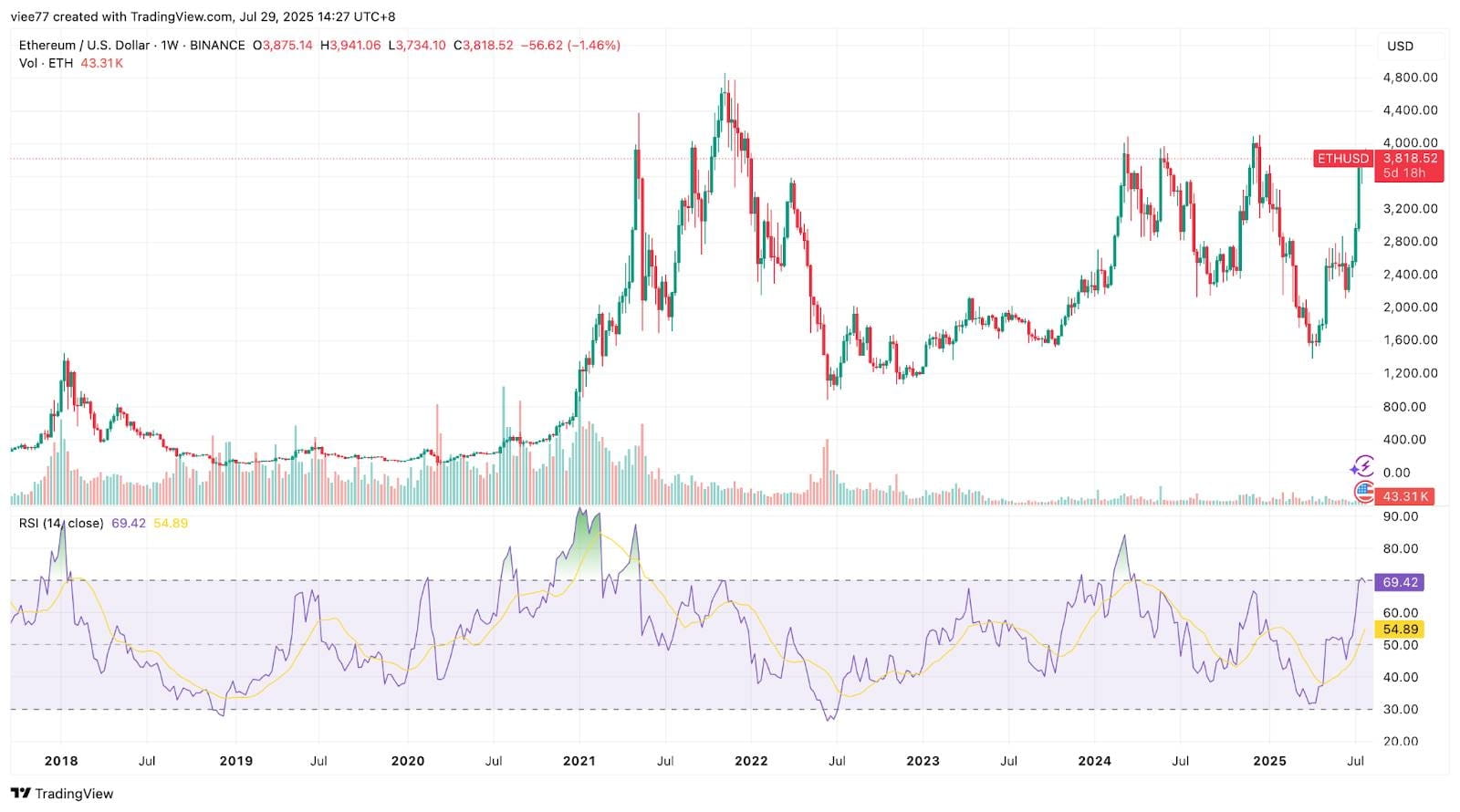
Source: TradingView
Analyst @MikybullCrypto had previously indicated this buying signal back in April, judging it to be an 'extremely rare buying point that should not be ignored' and predicting that ETH would double thereafter. He recently reiterated this view, believing that if RSI continues to rise to a high level, the price of Ethereum could reach the $7,000 to $10,000 range.
This suggests that, from a technical perspective, this round of Ethereum's rise may not be over yet.
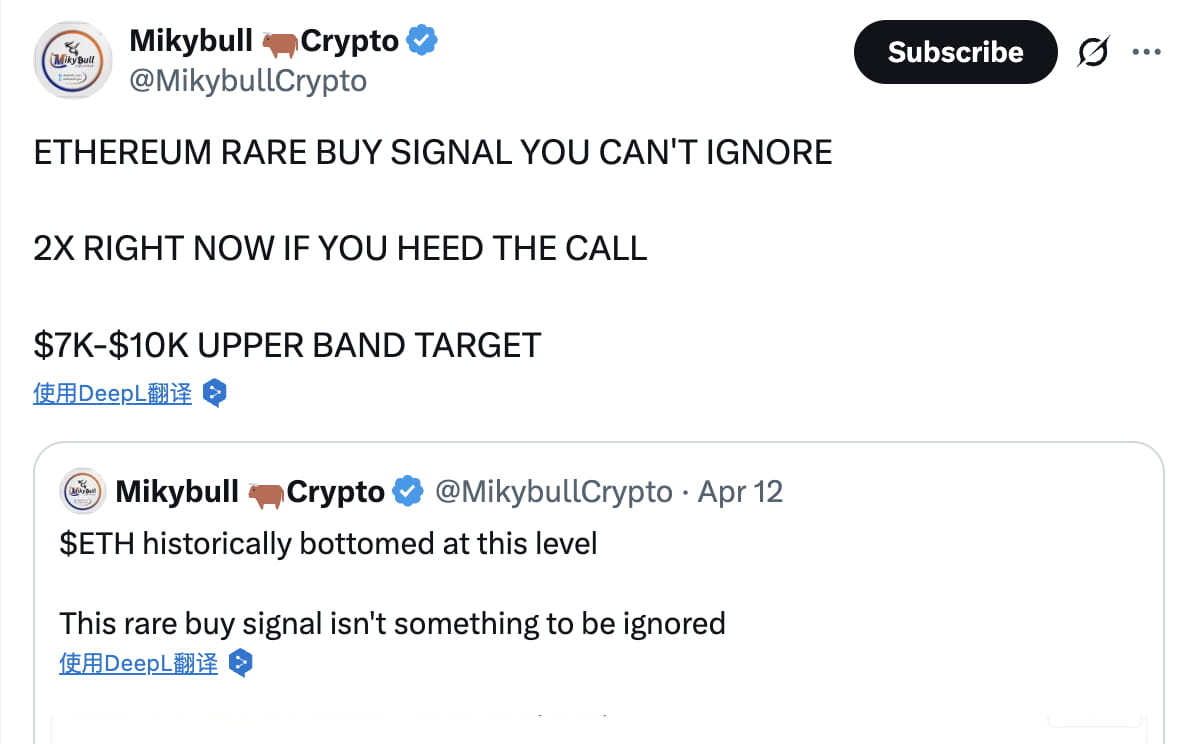
5. On-chain Indicators
On-chain data shows a significant increase in Ethereum's activity.
Trading Activity: The average daily number of transactions on the Ethereum mainnet has remained stable in recent months, with the total monthly transactions in June 2025 being approximately 42 million (about 1.4 million daily), remaining basically flat compared to previous months. It is noteworthy that although the current on-chain Gas fees are low, this may not be due to a decrease in users, but rather due to enhancements in network processing capacity after the mainnet upgrade, leading to a decrease in unit transaction costs. According to data from Nansen, in the past month, the number of active Ethereum addresses increased by 16.3% over the past 30 days, and the number of transactions grew by 14.2% in the past 30 days, reaching an average daily transaction count of 1.62 million on July 22, setting a new high in nearly six months. Active on-chain activities mean more users and applications are using the Ethereum network.
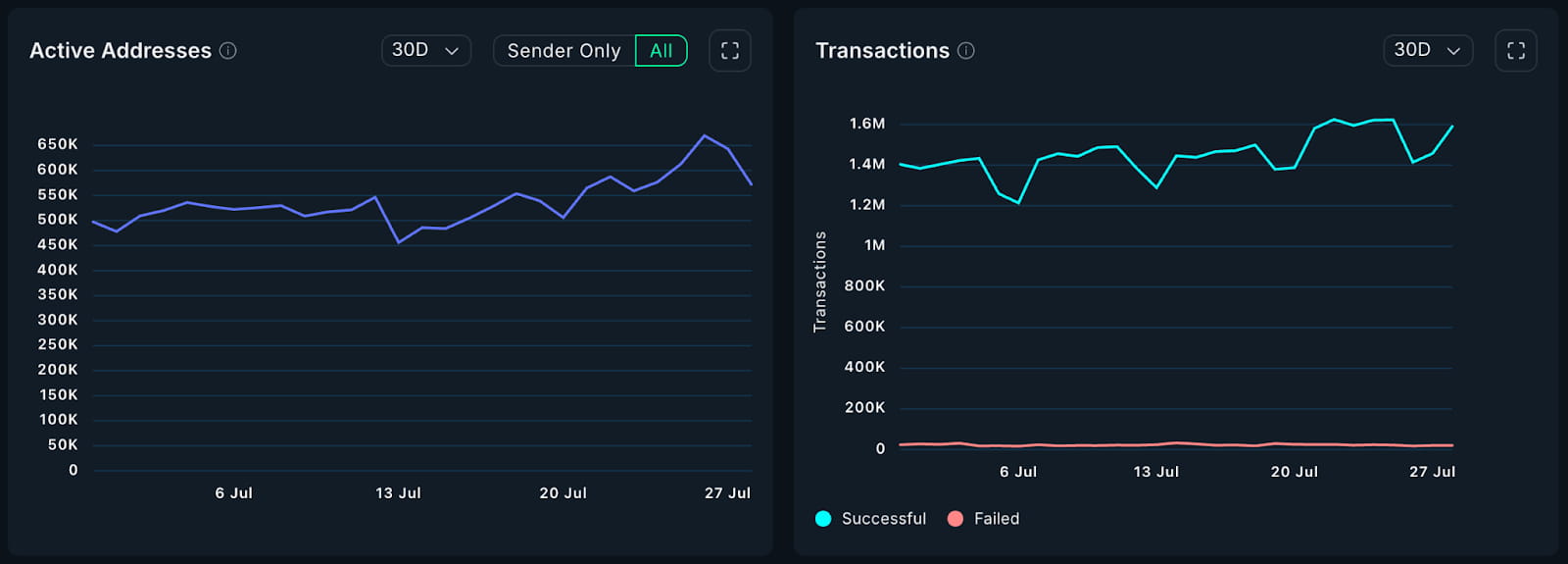
Source: Nansen
On-chain Fees: With the recent recovery of coin prices and on-chain activities, Ethereum's fee income has also rebounded and has once again surpassed other public chains, returning to the second position in on-chain fee income in the second quarter of 2025. According to Artemis data, Ethereum's total network fee income for June was approximately $39.1 million, second only to Tron, which to some extent reflects the return of demand for the Ethereum network.

Source: Artemis
Total Value Locked (TVL) in DeFi: The following DefiLlama data shows that Ethereum's TVL increased from $60.2 billion on June 28 to a three-year high of $85.9 billion on July 28, with a monthly growth of over 42%. Additionally, the total DeFi TVL across the network surpassed $153 billion in late July, setting a new three-year high, with nearly 60% locked in Ethereum. However, it is noteworthy that Ethereum's price increase during the same period was 59.9%, exceeding the TVL growth rate, and if measured in ETH terms, the TVL growth rate showed a 1% decline, indicating that the recent TVL record high was primarily driven by ETH price increases. This means that if asset prices retract, the TVL metrics may also correspondingly decline.
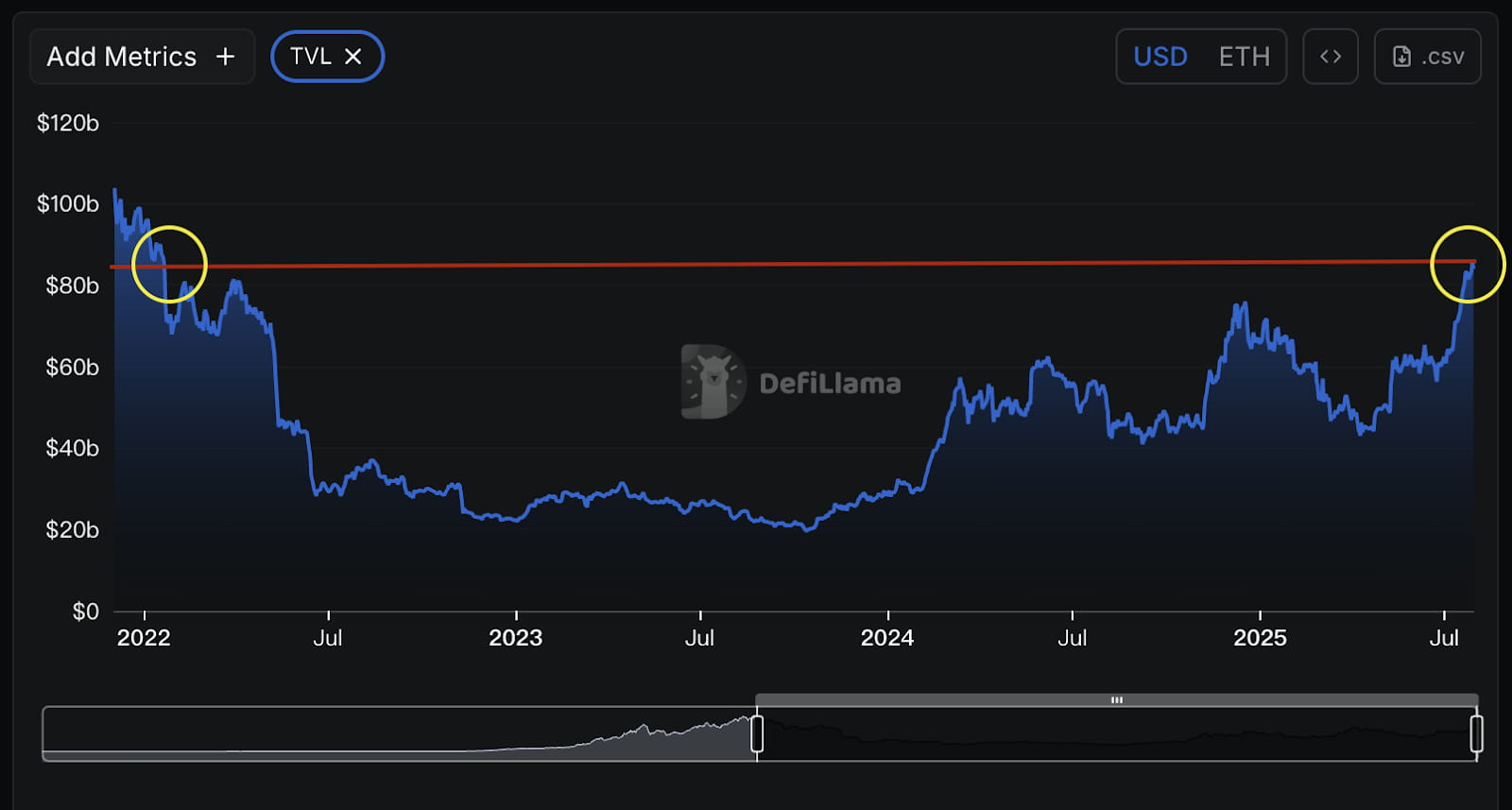
Source: Defillama (The above image shows ETH TVL)
Staking Situation: It is worth mentioning that Ethereum's staking scale has repeatedly hit new highs - currently, over 36 million ETH are staked, approaching 30% of the current total supply. These locked ETH effectively reduce the circulating supply, decreasing selling pressure from a supply and demand perspective. Although recently over 500,000 ETH queued for unstaking, a substantial amount of new staking has also entered, offsetting the impact of large exits, and the coin price remains strong without excessive panic.
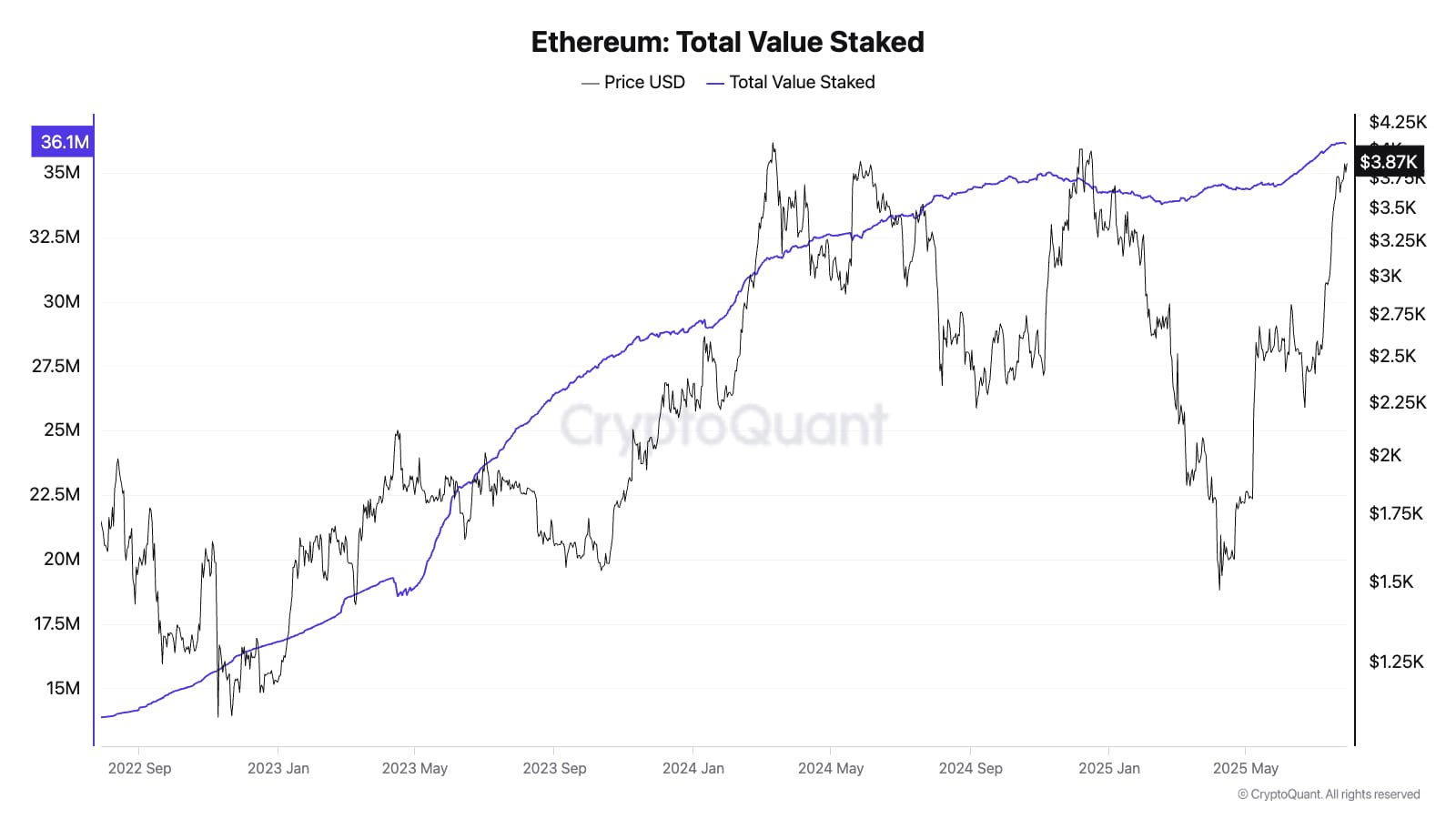
Source: Cryptoquant
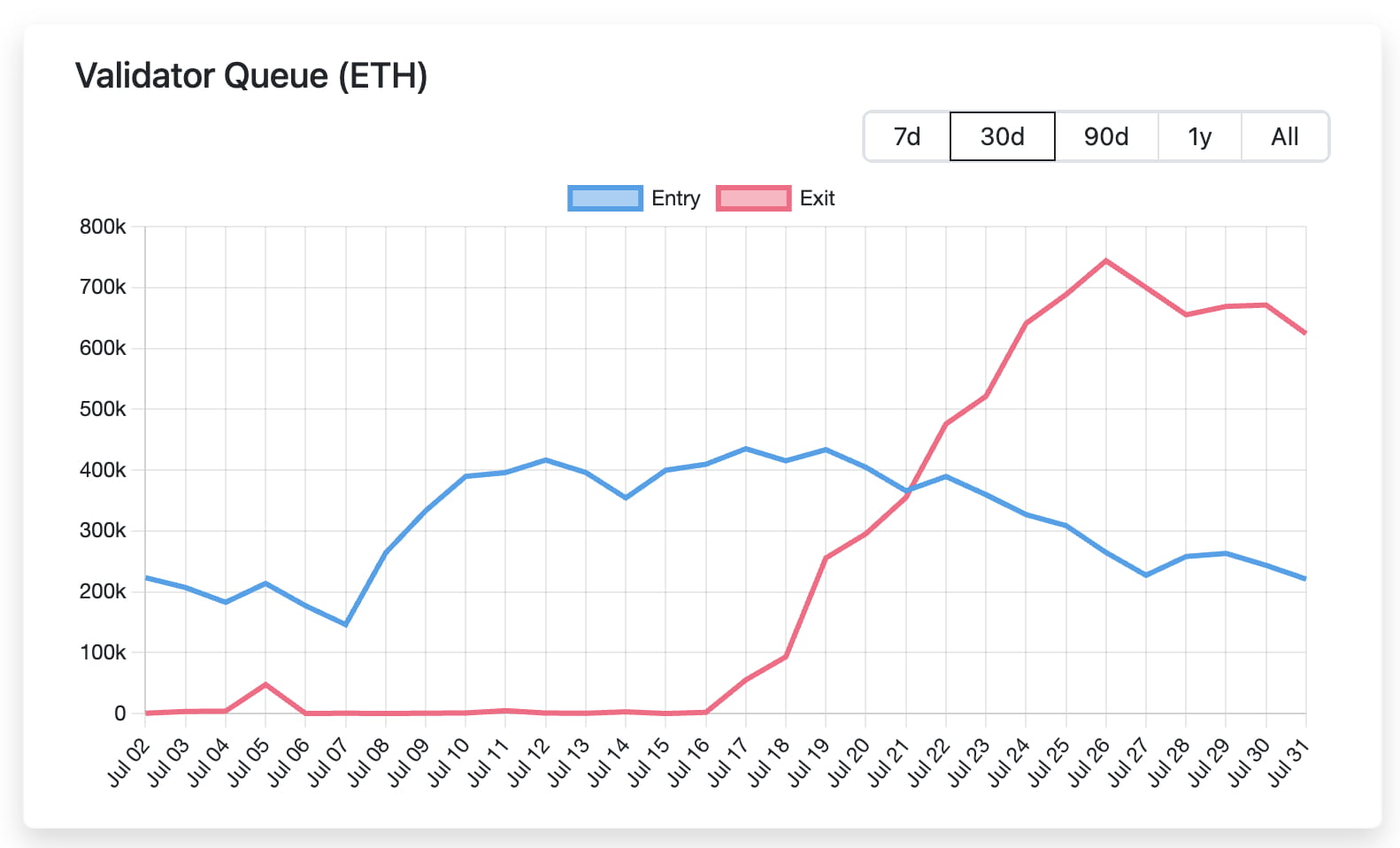
Source: validatorqueue
ETH Inflation Situation: It is worth noting that the current Ethereum network is showing a slight inflation state, with the actual inflation rate being far below the general market perception. According to statistics, since the merge, the average annual net inflation rate of Ethereum (+0.117%) has been over 11 times lower than Bitcoin's inflation rate (+1.338%). The logic behind ETH is that the more it is used, the more it is burned, forming a positive cycle of network activity, which means the traditional notion of 'ETH unlimited inflation' is no longer valid. In the past few years, ETH has substantively low inflation, which may also be one of the important supporting factors in its rising logic.
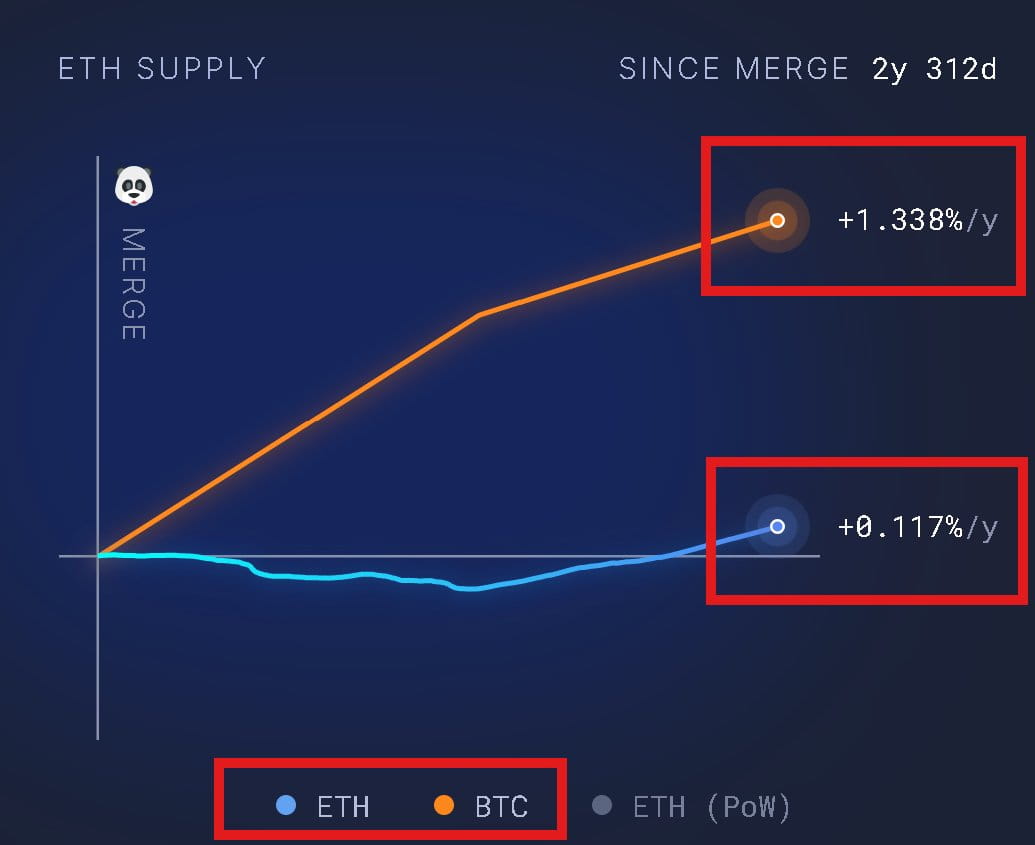
Source: ultrasound.money, @LeonWaidmann
The increase in transaction numbers + the recovery of fees + staking lock-up + low inflation levels, several on-chain indicators jointly support the positive fundamentals of Ethereum, providing strong support for ETH prices to continue to rise.
6. RWA and Stablecoin Narratives
By deeply analyzing the key indicators of various on-chain networks supporting RWA (see table below), it can be seen that Ethereum occupies a dominant position in the RWA and stablecoin market.
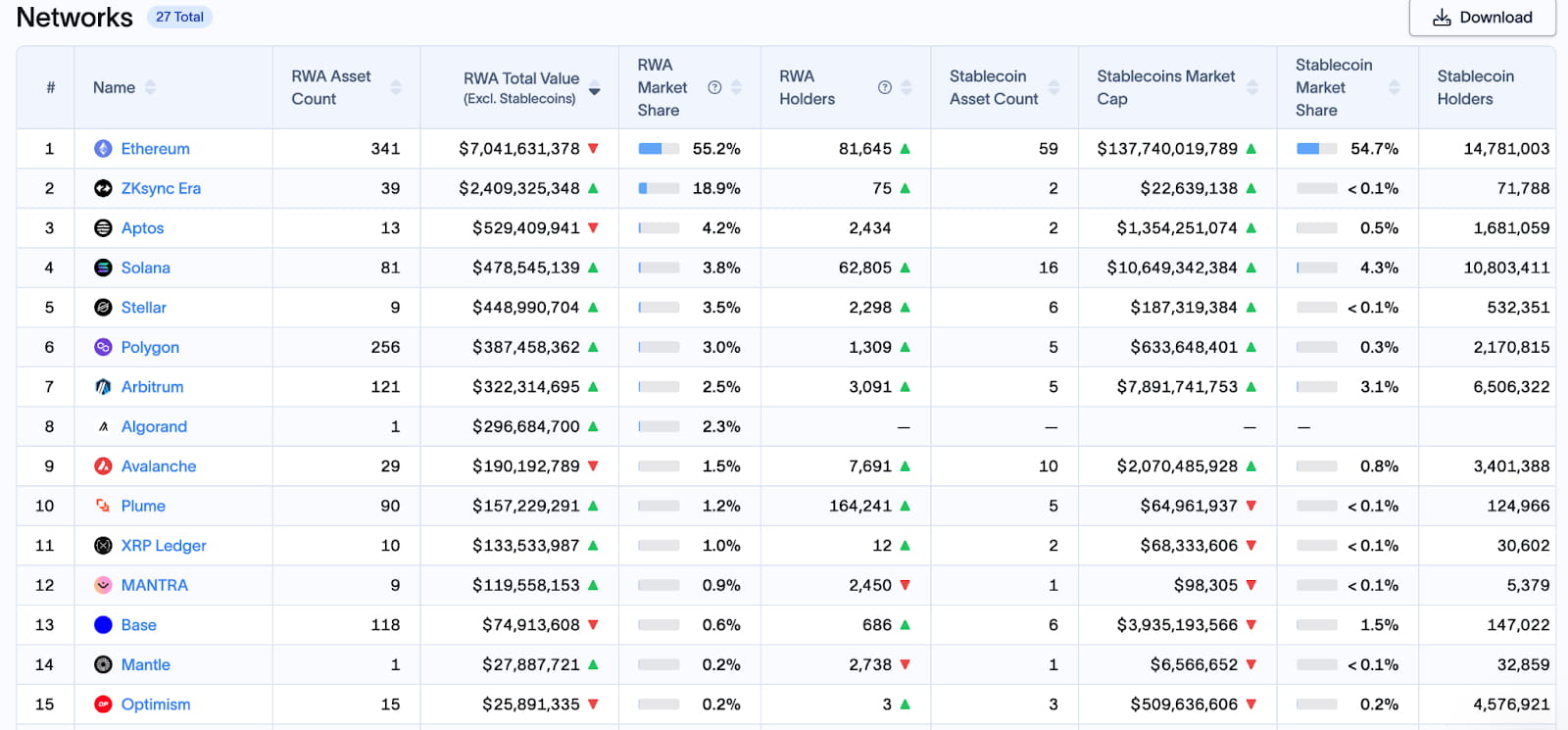
Source: RWA.xyz
RWA On-chain: 2025 is referred to as the 'RWA Year' by many industry insiders, as a large number of real-world assets are being tokenized through the Ethereum ecosystem. According to RWA.xyz data, as of July 29, 2025, over 341 types of RWA assets have been hosted on Ethereum, covering government bonds, real estate equity, private equity, etc., accounting for about 55.2% of the entire on-chain RWA market, reaching $7 billion, ranking first among all blockchains, about three times that of the second place ZKsync. For example, Blackrock's tokenized fund BUIDL has exceeded $2.4 billion, with over 90% of its assets still hosted on Ethereum. As the future RWA tokenization market continues to break through, Ethereum is expected to take the largest share.
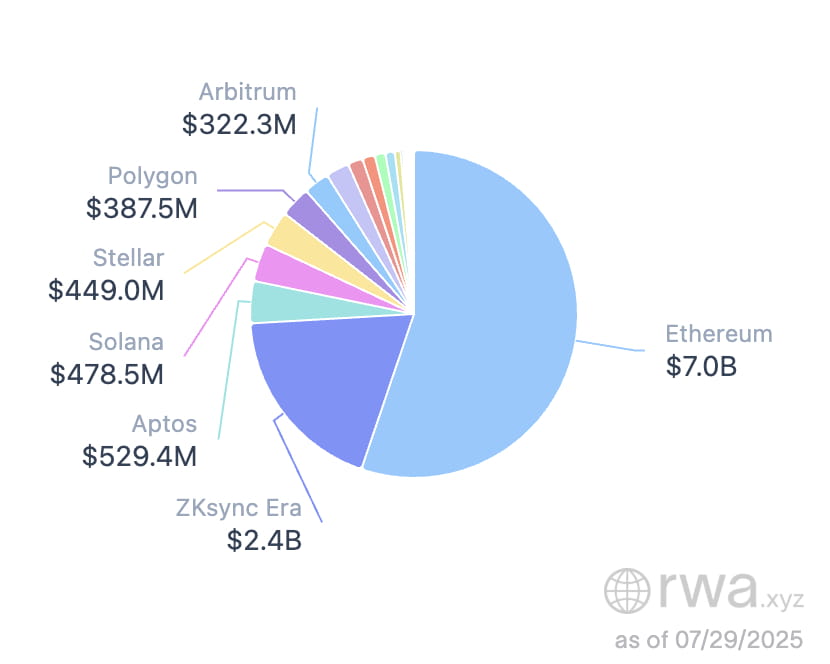
Source: RWA.xyz
Stablecoin Trends: Ethereum continues to solidify its position as the on-chain dollar carrier in 2025. As of July 29, 2025, the stock of stablecoins operating on Ethereum accounts for over 54% of the entire market, firmly ranking first among all public chains. Totaling approximately $250 billion, over $137.7 billion of stablecoins (such as USDT and USDC) circulate within the Ethereum network.
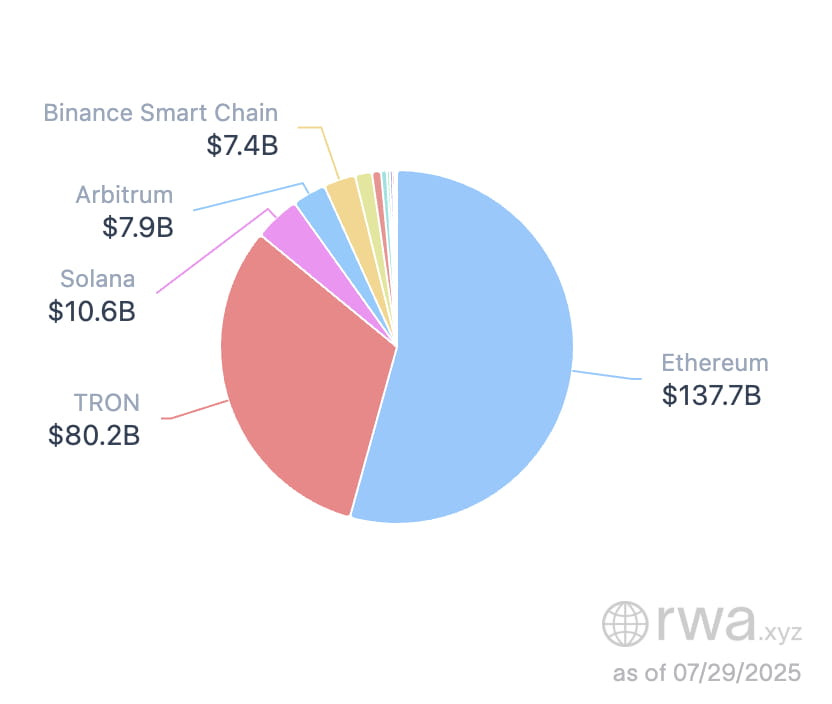
Source: RWA.xyz
It is important to emphasize that in the past, ETH was more seen as a 'super Bitcoin' crypto asset, but now, with the accumulation of stablecoins and RWA, ETH has broader value support. On one hand, ETH is indispensable as 'digital oil' for paying Gas; each stablecoin transfer and each RWA issuance requires burning a small amount of ETH; on the other hand, the 'productive asset' attribute of ETH is becoming increasingly prominent - staking ETH can yield native returns, similar to holding U.S. Treasury bonds for interest, closely aligning with traditional funds' preference for income-generating reserve assets. When entering a rate cut cycle, ETH's staking yield may exceed that of Treasury bonds, and with significant upside potential, this makes ETH highly attractive. Thomas Lee has publicly stated that Ethereum, as a platform for stablecoins and RWA, has unlimited prospects, making it the preferred choice for Wall Street's layout on compliant chains. Lee believes Ethereum's network value is severely underestimated, and its 'fair value' should be in the range of $10,000 to $15,000, with more than ten times appreciation potential in the coming years.
In summary, the rise of stablecoins and RWA is redefining ETH's investment value, allowing Ethereum the opportunity to become a global digital dollar clearing network, which is also one of the important reasons why institutional investors are daring to significantly allocate ETH recently.
7. Ethereum Technology Roadmap
Ethereum has been continuously iterating and upgrading over the past ten years, and the progress of its technology roadmap is an important internal driving force for the bullish outlook on ETH.
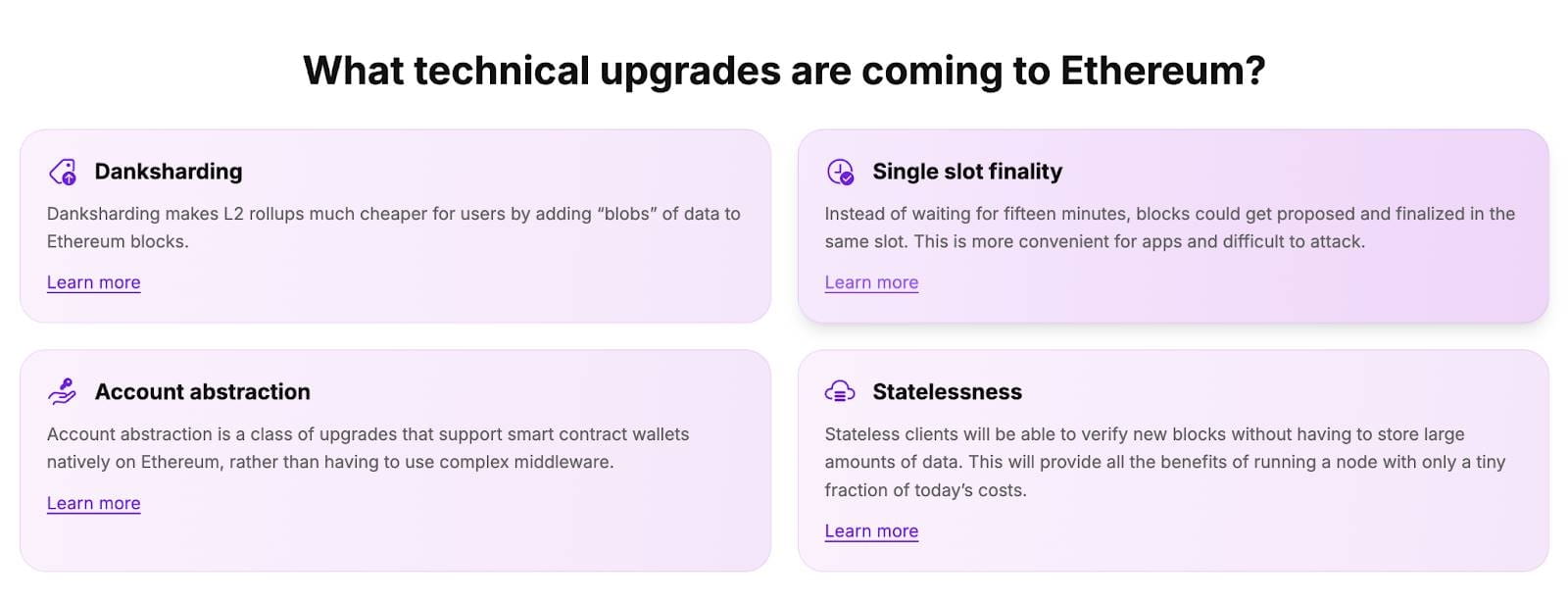
The most recent major upgrade - the Pectra upgrade, was successfully implemented on May 7, 2025. It integrates the Prague and Electra sub-proposals, covering changes in the execution layer and consensus layer. It introduces account abstraction (EIP-7702), increases the validator staking cap (to 2048 ETH), expands data (increases blobs), offers a more flexible exit mechanism, and includes BLS precompilation, aiming to enhance scalability and user experience, paving the way for future sharding and Verkle trees, marking a key step in Ethereum's long-term roadmap.
In the next phase, the Fusaka upgrade is expected to go live around the end of 2025, expanding the number of data blobs per block by 8 times and introducing PeerDAS technology to enhance on-chain data availability.
Overall, the Ethereum development roadmap has been advancing as planned over the past quarter, including Proto-Danksharding, deepening account abstraction, data expansion, and reforms to the validator mechanism, continuously enhancing Ethereum's performance. Looking ahead, Ethereum will strive to complete Danksharding full sharding, achieve Statelessness, and improve various modular segments; the enhancement of Ethereum's performance will also lay a solid foundation for the long-term value of ETH.
Summary
In summary, standing at the ten-year anniversary of Ethereum, we can see the resonance between the internal fundamentals and the external environment: core indicators improving, continuous technological upgrades, and optimized team governance, making the Ethereum network more robust; at the same time, the emerging narratives of stablecoins and RWA, along with the incremental funds brought in by ETFs, inject a continuous driving force for ETH's rise. For this reason, more and more asset management institutions and analysts are optimistic about Ethereum's medium- to long-term prospects, believing it is likely to challenge new heights in the coming years.
Of course, challenges from other public chains, regulatory changes, and more may still bring volatility. But it can be confidently stated that at the starting point of the next decade, Ethereum is transforming towards a 'new financial infrastructure,' and the excitement may just be beginning.
Continuously pay attention to SPK ATM SC A2Z

